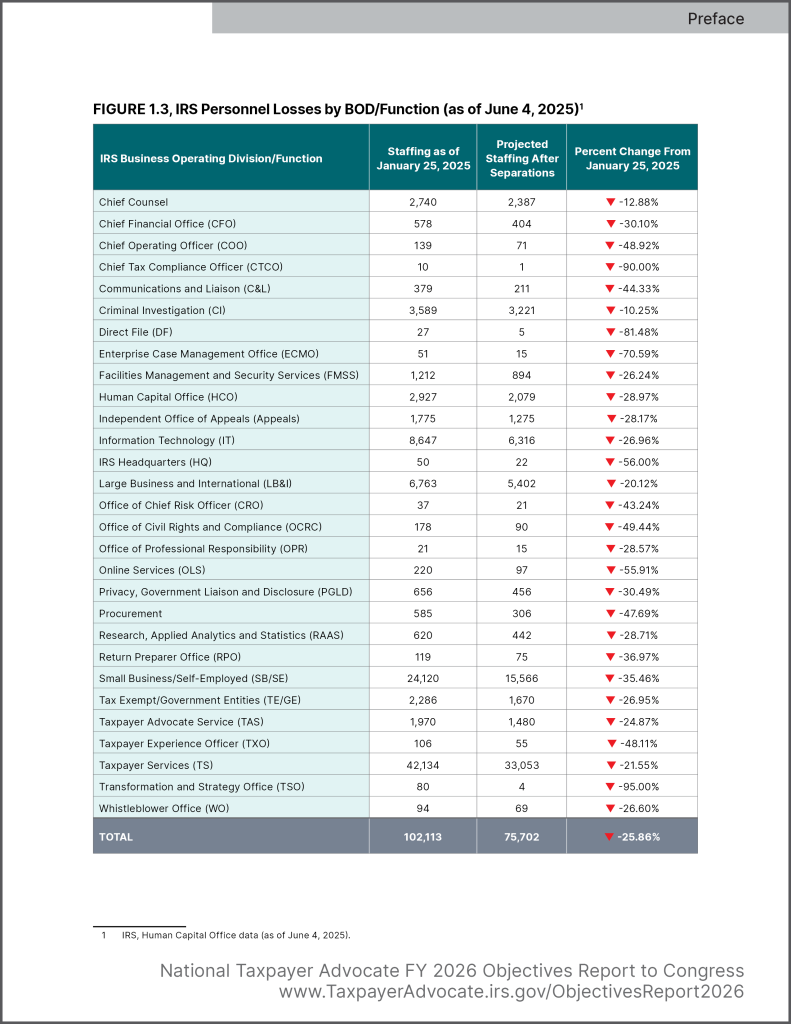

On June 25, I released my mid-year Fiscal Year 2026 Objectives Report to Congress. In it, I praise the IRS for running its best filing season in recent years. It received nearly 141 million individual income tax returns and processed about 138 million without issues for most returns.
Despite experiencing operational uncertainties, telework transitions, and the specter of workforce reductions, IRS employees have continued to uphold the agency’s mission with resilience and dedication and to diligently perform their jobs.
Regardless of one’s views about the ultimate size of the IRS workforce, we owe both IRS and TAS employees a tremendous debt of gratitude for meeting the needs of our nation’s taxpayers. Each year, IRS employees are instrumental in collecting about $5 trillion in revenue for our nation, processing about 180 million income tax returns and over five billion information forms. Taxpayer Services employees provide taxpayers with guidance and assistance throughout the year, while revenue agents and collection officers help ensure that taxpayers pay what they owe to fund critical government programs, including national defense, Social Security, and Medicare. And while many IRS employees may not engage directly with taxpayers, their support to tax administration is key to the IRS’s success. I am particularly thankful for my TAS staff, which has continued to work tirelessly to resolve tens of thousands of taxpayer account issues where taxpayers have not been able to get help through normal IRS channels.
It’s not all sunshine and rainbows though. The IRS continues to face significant, ongoing challenges. As we look ahead to the 2026 filing season, I am concerned by the personnel reductions the IRS has been experiencing. This presents an operational risk that looms over next year’s filing season, particularly because Congress is poised to enact significant tax legislation that will make the job harder than usual.
Between the start of the 2025 filing season and June, the IRS workforce decreased from about 102,000 employees to fewer than 76,000; that’s a 26 percent reduction.

To deliver a successful filing season, the IRS needs trained employees. For example, it needs Information Technology (IT) employees to reprogram IRS processing systems to reflect changes in tax law, while personnel in Taxpayer Services process tax returns, answer taxpayer telephone calls, and process taxpayer correspondence, among other things.
As of this month, as Figure 1 shows, IT staffing has been reduced by 27 percent, and Taxpayer Services staffing has been reduced by about 22 percent, or by more than 9,000 employees. The Administration’s FY 2026 budget proposal calls for keeping Taxpayer Services staffing at about FY 2025 levels (taking into account both appropriated funds and Inflation Reduction Act funds). Until the IRS effectively implements IT solutions, it requires well trained employees to process the returns. Thus, the IRS will need to rapidly hire and train thousands of new Taxpayer Services employees before the start of the 2026 filing season to process returns and deliver timely refunds.
It is essential that the IRS prepare for and efficiently execute the next filing season. The continued staffing constraints, combined with stagnant technology and potential legislation changes, jeopardize next year’s success. Early preparation ensures the IRS can deliver both effective taxpayer service and secure operations.
To learn more, read my Fiscal Year 2026 Objectives Report to Congress.
The views expressed in this blog are solely those of the National Taxpayer Advocate. The National Taxpayer Advocate presents an independent taxpayer perspective that does not necessarily reflect the position of the IRS, the Treasury Department, or the Office of Management and Budget.